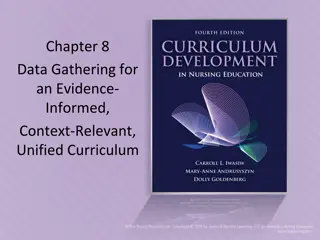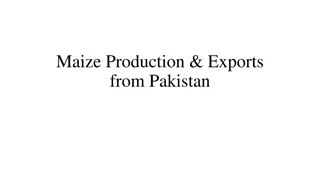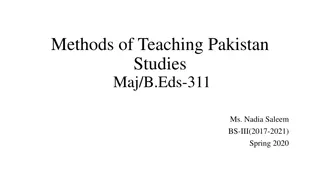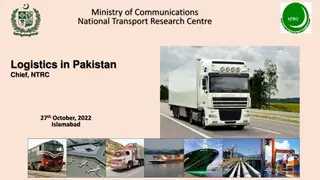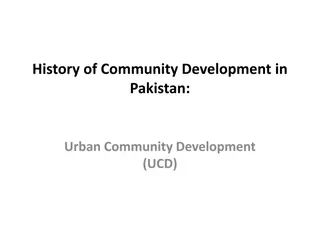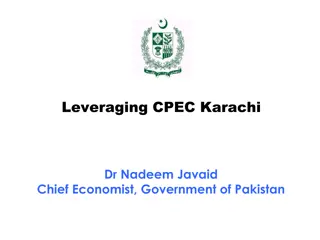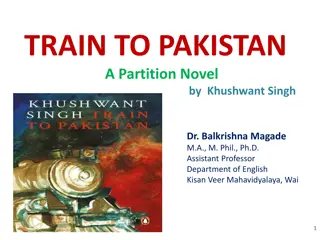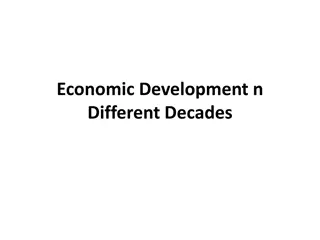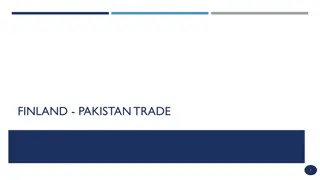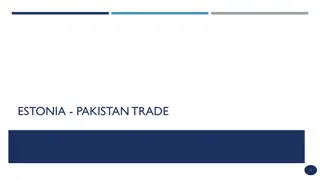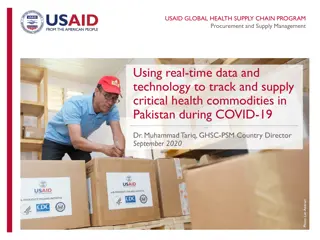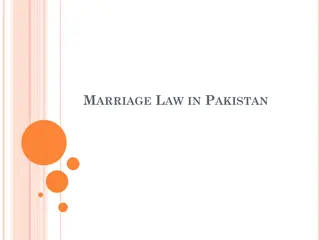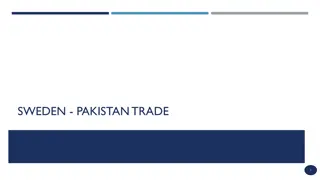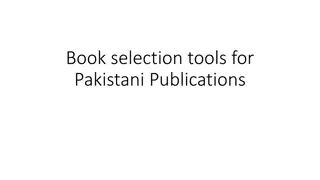Curriculum Development Process in Pakistan's Education System
The curriculum development process in Pakistan's education system is governed by the Federal Ministry of Education and implemented at the provincial level. The education system consists of three tiers: Elementary (grades 1-8), Secondary (grades 9-12), and University programs. The curriculum focuses on eight common disciplines including Urdu, English, Mathematics, Science, Arts, Social Studies, Islamiyah, and Computer Studies. Science education integrates biology, chemistry, physics, and earth sciences at different levels. The medium of instruction is primarily Urdu, with English introduced as a second language.
Download Presentation

Please find below an Image/Link to download the presentation.
The content on the website is provided AS IS for your information and personal use only. It may not be sold, licensed, or shared on other websites without obtaining consent from the author.If you encounter any issues during the download, it is possible that the publisher has removed the file from their server.
You are allowed to download the files provided on this website for personal or commercial use, subject to the condition that they are used lawfully. All files are the property of their respective owners.
The content on the website is provided AS IS for your information and personal use only. It may not be sold, licensed, or shared on other websites without obtaining consent from the author.
E N D
Presentation Transcript
Lecture Unit 5: process of curriculum development in Pakistan B.Ed. (1.5 years) Semester I Subject: Curriculum Development Represented by: Ms. Sadia Tariq Department Of Education (Planning And Development) Lahore College For Women University, Lahore
Process of Curriculum Development in Pakistan Pakistan governed under Islamic, democratic, federal constitution of 1973 is comprised o four autonomous provinces: Punjab, Sindh, Khyber Pakhtunkhwa and Baluchistan. All of provinces have its own educational setups but Federal Ministry of Education has been empowered through the Federal Supervision of Curricula.
6.1. Curriculum Development at Elementary and Secondary level Education in Pakistan is provincial affair. Therefore, in order to ensure national cohesion, integration and preservation of the ideological foundation of the State, certain educational functions are the responsibilities of Federation, via the Federal Ministry of Education. These responsibilities are: curriculum syllabus planning policy centers of excellence standards of education
6.1.1 Education in Pakistan In Pakistan, education system has three-tier: Elementary (grade1-8): elementary education in Pakistan has two stages; Primary stage: It comprises classes 1 to 5 and enrolls students of age group of 5+ to 9+ Middle stage: A three year middle age consists of classes 6 to 8 corresponding to age group 10+ to 12+
Cont.. Secondary (grade 9-10): has also two stages; High: grades nine and ten leading to the Secondary School Certificate Intermediate: grades eleven and twelve, leading to Higher Secondary School Certificate. University programs: which lead towards advanced degrees.
Cont.. The eight common disciplines are Urdu, English, Mathematics, Science, Arts, Social Studies, Islamiyah and sometimes Computer Studies. Science is taught as compulsory subject in an integration of biology, chemistry, physics and earth science at primary and elementary level. At secondary school level, science is an optional subject and those who opt it, study physics, chemistry and biology. Courses offered throughout Pakistan are generally same and diversification in courses takes place after class 8. The medium of instruction is schools is Urdu but English is also introduced as second language.
Cont.. Schools in provinces also teach their regional language but in Sindh, Sindhi language can be opt for medium of instruction in schools. Integrated curricula for grade 1 to 3 has been introduced. The curricula in various disciplines were drafted by National Committee consisting of majority of subject experts from the Universities.
6.1.2 Role of Ministry of education The main function of Ministry of Education is to plan and review the National Curriculum and to make it more vibrant for the need of country and comparable for international level. The role of Ministry of Education is: To carry out international comparison concerning current trends in curriculum development. To identify National Curriculum Framework. To review main principles of new national curriculum policy. To set up structure for curriculum review and revision.
Cont.. To delegate tasks for curriculum reform process, such as: Establish mechanism to identify students needs. Develop guidelines for design of syllabi according to new national standards. Develop principles of transitions form old to new curriculum. Integrate changes with areas like: teacher development, textbooks, assessment and examination system. Develop training and awareness programs for Educational officers. Develop parents and community awareness campaigns.
6.1.3 Role of curriculum wing The Federal government through a notification in1976, nominated the Curriculum Wing of Ministry of education as competent authority for curriculum development form grades early childhood to 7 and from grade 7 to onwards is the responsibility of HEC. The role of curriculum wing is: To prepare schemes of studies, curricula, manuscript of textbooks and schedules to introduce in various classes of an institution. To approve manuscripts by other agencies before implementing in various classes.
Cont.. To direct any person or agency in writing to delete or amend any portion or whole curriculum within a period in these specified directives: Development of experimental edition of primary school text books. Improvement of quality of printing and award of prizes. Development of supplementary readers. Promotion of concept for use of multiple textbooks.
6.1.4 Textbook Board Four provincial textbook boards (PTTBs) are established in four provinces and they all work under the purview of Federation. Within their respective jurisdictions, these PTTBs are responsible for preparing, publishing, stocking, distributing and marketing school textbooks. PTTB develops these books through open biding called the draft manuscript of the book based on approval curricula. The finally selected manuscript is passed on to the curriculum wing for it s approval.
Cont.. The curriculum wing reviews it and in case, if it is found to be worth presentation before National Review Committee (NRC), comprising highly qualified professionals in textbook development with specified term of reference. In case it is accepted then curriculum wing issue certificate to print an implement in specified areas. PTTB also preform some other functions: Research and survey of textbooks by staff of Textbook Boar. 1. Training of authors, writers, designers, etc. of textbooks. 2.
6.1.5. Quality Challenges In each province quality challenges are spread across the following intuitions: Bureau of Curriculum Textbook Boards Teacher Training Institutions Board of Intermediate and Secondary Education National education Assessment System and provincial education (grade 5 and grade 8) Assessment centers (PEAC).
Cont.. Punjab Education Commission (PEC) restricted to province of Punjab. The first five are present in each province .Punjab has launched its own examination commission. These all institutions are responsible of quality of education with direct links with ministry of education in assessing learning competences, quality learning and teaching processes, textbook development, curriculum and inputs to policy reforms.
6.1.6. Mechanism of Curriculum Development in Pakistan Steps Mechanism of curriculum development in Pakistan follows these steps: Curriculum wing request the provincial centers to prepare draft curriculum for each subject taught in various classes up to class twelve. Provincial centers call of committee of teachers, subject specialists and experts on each subject Provincial curriculum committees prepare curriculum plan. The draft plan is sent to curriculum wing. Curriculum wing circulates the drafts to the selected teachers, subject specialists, in school colleges and other agencies concerns and invites their comments.
Cont.. The comments are reviewed in curriculum wing. The national committee of curriculum scrutinizes the draft in the light of comments. The committee submits its recommendations to the ministry of education Secretary education accords necessary approvals The curriculum schemes duly approved are passed on to the provincial text book boards of preparation of textbook.
6.2 Role of teachers in curriculum development process at various levels Teachers know the needs of all stakeholders of teacher education. Teachers can understand the psychology of the learner and aware about the teaching methods and teaching strategies. They also play the role as evaluator for the assessment of learning outcomes. So teachers must possess some qualities such as making developing and implementing. Teachers play the respective role for the each step of curriculum development process.
Cont.. Teacher plays role as: Maker: Teacher writes a curriculum daily through a lesson plan or an early plan .The addresses the goals, needs interest of learners by creating experiences where the student learn better Developer: The teacher as a curriculum developer designs, enriches and modifies the curriculum to suit the learners characteristics. Implementer: In this stage , the teacher gives life to the written materials Its role has shift from learning to doing such as guiding , facilitating and directing activities
Other roles of Teacher in curriculum development Active learning: Curriculum as a content, but when contextualized, it comes alive for students. The role of teachers in the curriculum process is to help students develop an engaged relationship with the content. Active learning will increase the focus and retention of the curriculum, resulting in an exciting learning environment. Teachers build lessons that include simulations, experiments, case studies and activities to deliver curriculum. The curriculum process provide opportunity for teachers to be creative and put their unique stamp on the classroom experiences
Cont.. Multiculturalism: During the Curriculum Development , teachers use a prescribed curriculum to build lessons that have global impact. Example: Teachers integrates examples of diverse people who have made significant contribution on the content area. The intentionality of building inclusion helps dispel stereotypes and to encourage students to look favorably upon diverse group. Teachers can provide supplemented materials during the curriculum process. Finally, the curriculum process enables teachers to consider how they can best deliver lessons that will reach English language learners , or other delivers populations
Cont.. Incorporating students choices: During the Curriculum process, teachers consider how they can incorporate student choice into classroom learning. Teachers can help student to connect to content to an individualized plan that reflect a career interest. Project based learning is a dynamic option that teacher s must plan in advance, during the curriculum process. This hands on technique immerses students in a practical project that brings alive the classroom curriculum
6.3 Changes and issues to curriculum development In Pakistan the curriculum prepared by policy makers is the "official curriculum." It is meant to be taught and learned and is imposed with a "top down" approach for its adoption and implementation. Teachers are expected to implement it rigidly. Although it is a plan for learning a program for' all experiences, which the learner encounters under the direction of the school, these theories are not often translated into practice. This curriculum is intended as "all of the experiences children have under the guidance of the teacher", but because these "experiences" are generally not defend, they appear vague and are therefore difficult for teachers to implement.
Cont.. In addition, children often do not share the experiences or have the cognitive structures assumed by teachers. This curriculum therefore does not "encompass all learning opportunities provided by the school", nor does it provide for both "directed" and "undirected" opportunities for learning. With the practice of this narrow understanding, curriculum in Pakistan remains a "specified fixed course of study". Children are considered to be the "beneficiaries" of this official fixed document although it may not be based on student needs or interests. This curriculum emphasizes transmission of knowledge, teacher skills of lecturing and demonstrating, and prescribed textbooks and guidelines.
Cont.. The affective domain of children goes unnoticed because of this "highly authoritative" kind of leadership in schools and classrooms. Several attempts have been made to import innovative curriculum models and approaches from the West, such as integrated curriculum, a child-centered approach, developmentally appropriate practice, cooperative and constructive learning, reflective practice, and others. However, these approaches are not sustained because they are initially taught by "experts" from outside the teachers own schools, and, because of lack of "ownership" during the curriculum planning stage, teachers are unable to handle these developed concepts. Thus there occurs a mismatch between curriculum and curriculum implementers.
6.3.1 Curriculum Development Pitfalls Several major obstacles affecting the quality and effectiveness of the curriculum development process in Pakistan, are summaries below: 1. Expertise: Some teachers are involved in curriculum development but their contribution to the curriculum development is nominal, the reason is lack of expertise. The existing training programs and teachers academic qualification do not necessarily contribute to curricular activity. Therefore, at best, the teaches are able to provide opinion about the compatibility between specific concept or content and the intellectual development level of the children in the specific age group or grade.
Cont.. 2. Textbook quality: Textbook often do not reflect the curriculum. All important self-assessment questions or activities are invariably missing. It requires considerable experience to translate the curriculum that covers the objectives; consideration the children language proficiency and background knowledge; concurrently arrange the content in a logical sequence. .
Cont.. 3. Implementation and the follow up: The third problem is that there is lack of follow up of actual curriculum implementation in classroom practice. The curriculum in actually implemented generally different from the official curriculum document. The classroom teacher does not take into account the educational objectives. No evaluation of the implemented curriculum is carried out; hence no feedback is received to revise the curriculum.
6.3.2 Factors effecting curriculum development in Pakistan Curriculum development is influenced by several factors. Several factors affect all curriculum development tin meeting the needs of 21stcentury learners in both organized academic settings and corporation learning centers. They are: 1. Politics: Politics affect curriculum development. In numerous ways. All aspects of curriculum depends upon local, provincial and national political standards. Politics determine and define the goals, contend, learning experiences and evaluation strategies in education.
Cont.. Curricular materials and their interpretations are usually heavily influenced by political consideration. Political considerations may play a part in hiring of personal. Funding of education is greatly influenced by politics. Enter into educational institutions and the examination systems are heavily influenced by the politics
Cont.. 2. Economics: Economics influences curriculum development. The children who are to be taught, will need to be employed. The skills needed by industry should be translated into the content and learning experiences of these children. These skills, knowledge base and attitude required by industry should be developed in classroom. As a teacher, you requires classroom supplies such as: textbooks, charts, equipment and chemicals for science experiments
Cont.. These materials are products of industry Without these materials, learning is compromised It id therefore crucial that serious consideration be given to economics demands when developing the curriculum. 3. Social factors: A multicultural society also influences curriculum design. Factors of diversity includes: religion, race, gender, ethnicity, socio-economic status, age and also children with different kids of disabilities. Society has its own expectations that should be considered while designing curriculum.
Cont.. 4. Technology: Technology driven curriculum development is the norm of 21stcentury. Technological multimedia influences educational goals and learning experiences among students. The computer is latest technological innovation. If one is not computer literate, he is not up to date. Curriculum designers cannot afford to ignore technology and its influenced on the curriculum.
Cont.. 5. Diversity : Curriculum development affect from diversity opens learning opportunities. Social diversity including religion, cultural and social grouping affects curriculum development. Developing relevant curriculum takes into account society s expectation. 6. Learning theories: Psychology of learning theories affects curriculum development. Understanding the psychology behind learning theories in curriculum development maximizes learning with content, delivery, interactive activities and experiences.
Cont.. Theories of learning and child development have to be considered when designing the content of the curriculum 7. Environment: Environment issues affect curriculum development. world awareness and action towards reversing and ending pollution continues affecting curriculum development. For example ozone layer in the atmosphere which protects us from harmful radiations from the sun is being depleted. It is through education that remediation can be effected. Consideration for the environment has to be considered in curriculum development to ensure the survival of future generations.
Cont.. 8. Classroom management: Classroom management is another factor that influences curriculum design. It is about achieving order in classroom, so productive learning can occur. The ultimate goal of classroom management is to promote learning. Learning means the teacher is getting the curriculum across to the students, which is ultimate goal in the carrier.

 undefined
undefined





